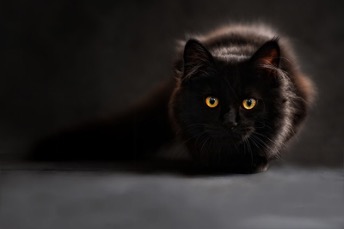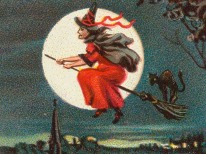
Black Cats – Purrfectly Normal
Black cats are synonymous with Halloween. Their likeness can be seen everywhere during this time of the year. While they may be celebrated during the Halloween season, this is unfortunately the result of their dark reputation and association with witchcraft. Has it always been like this for black cats?
A Stellar Start
Cats were first domesticated in the Fertile Crescent, and they became very popular during ancient Egypt.1 In ancient Egypt, cats of all colors were valuable because of their ability to catch vermin like rats, mice, and snakes. They even became revered in Egyptian culture. For example, Bastet, the goddess of the home, domesticity, fertility, and childbirth in Egyptian mythology, is depicted as a woman with the head of a black cat. In ancient Rome, cats of all colors were seen as a symbol of liberty. In China and Japan, cats were valued for protecting important documents from rodents.2 The story of Puss in Boots actually originated from an Indian folktale in the Panchatantra.3 Cats of all colors, including black cats, were often seen as not only beneficial, but revered in many cultures.
So… What Happened?
While it is difficult to pinpoint the exact causes that changed people’s attitude toward black cats, common theories point to the introduction of new religion. As Christianity was spreading through Europe, pagan customs and traditions started being vilified by the church to gain followers. In the early 13th century, the Christian Church began to draw on the pre-existing link between cats and witchcraft to associate cats with evil. In 1233, Pope Gregory IX issued the Vox in Rama, which was said to be the first official document demonizing black cats. The Vox in Rama contained descriptions of a German cult initiation that included kissing the behind of a black cat; the devil that the cult worshipped was half-man, half-cat.4 In 1484, Pope Innocent VIII issued a papal bull, Summit desiderantes affectibus, which included description of cats as “the devil’s favorite animal and idol of all witches.”5 Due to their coat color, black cats are also easily associated with the evil and fears of the unknown.

How is it going now?
The superstition and negative association toward black cats still lingers to this day, and this has done them no favors. Black cats are less likely to be adopted than cats of other colors, regardless of if they are kittens or adults.6,7 They also have the highest euthanasia rate in shelters.7 Fortunately, the stigma associated with black cats is just superstition - so the general public can safely consider providing these cool cats a forever home if they are looking for a feline companion. As a celebration for black cats, here are some famous, fictional, and real-life black cats!
- Felix the cat - the character first debuted in the 1919 animated short “Feline Follies” and was named “Master Tom”.
- Snowball II - Family cat of the Simpsons family. Snowball II was actually the fifth cat of the Simpsons’ family, but Lisa renamed the cat “Snowball II” to “save money on a new dish”.
- Salem Saberhagen- The black cat from “Sabrina the Teenage Witch”. Salem is actually a witch who was sentenced to spend 100 years as a cat as punishment for trying to take over the world.
- Oscar the bionic cat- A real-life black cat! In 2009, Oscar had both hind paws severed by a combine harvester. As part of his treatment, he received a first-of-its-kind surgery for prosthetic feet. The same implant technology is currently tested on humans as well; a great win for One Health!
References
- Science Reference Section, Library of Congress. How did cats become domesticated? Library of Congress, Washington, D.C. 20540 USA. Accessed October 5, 2022. https://www.loc.gov/item/how-did-cats-become-domesticated/
- Zax D. A Brief History of House Cats. Smithsonian Magazine. Accessed October 5, 2022. https://www.smithsonianmag.com/history/a-brief-history-of-house-cats-158390681/
- Opie, Iona, Opie, Peter. The Classic Fairy Tales. Oxford University Press; 1980.
- Engles, Donald W. Appendix III: Pope Gregory and the Vox in Rama. In: Classical Cats: The Rise and Fall of the Sacred Cat. Routledge; 2001:183.
- Deyrmenjian M. Pope Innocent VIII (1484-1492) and the Summis desiderantes affectibus. Malleus Maleficarum. Published online January 1, 2020. https://pdxscholar.library.pdx.edu/mmft_malleus/1
- Kogan LR. Cats in Animal Shelters: Exploring the Common Perception that Black Cats Take Longer to Adopt. Open Vet Sci J. 2013;7(1):18-22. doi:10.2174/1874318820130718001
- Carini RM, Sinski J, Weber JD. Coat Color and Cat Outcomes in an Urban U.S. Shelter. Anim Open Access J MDPI. 2020;10(10):1720. doi:10.3390/ani10101720
Follow us on LinkedIn for the latest updates on all things happening here at BSM Partners.
About the Author
Dr. Dan Su works at BSM Partners as Director of Nutrition Services. His areas of expertise include nutritional management of dogs and cats, and the culinary arts. As a food and animal enthusiast, Dan loves to give his pets food names. He is the proud owner of a cat named Gravy.
This content is the property of BSM Partners. Reproduction or retransmission or repurposing of any portion of this content is expressly prohibited without the approval of BSM Partners and is governed by the terms and conditions explained here.